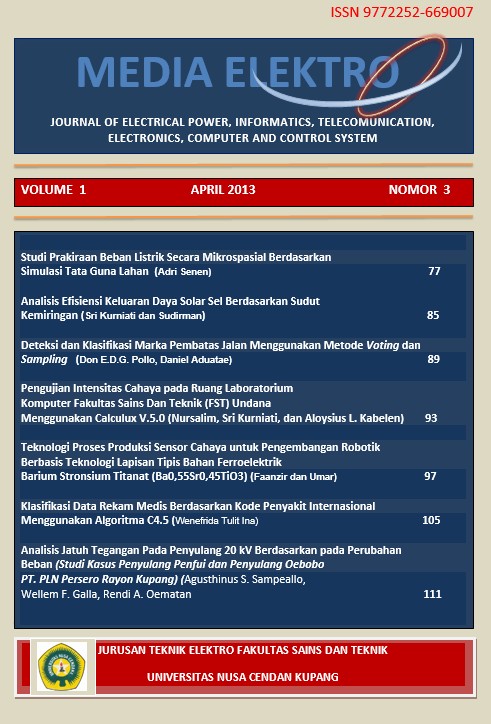STUDI PRAKIRAAN BEBAN LISTRIK SECARA MIKROSPASIAL BERDASARKAN SIMULASI TATA GUNA LAHAN
Abstract
Current electricity load forecasting sectoral become simpler and easier to implement. However, these conditions are faced with a situation where the results of macro forecasts still so do not show the load centers on a smaller area (grid) and resulted in no distribution substation location can be determined with certainty. In addition, the accuracy would tend to bias in a region that has limited data and the area of land use change that fast. Therefore, in this paper will outline the problem by conducting research on the electric load forecasting smaller area. This research method is to use clustering techniques to overcome the problem of the large volume of arithmetic processes. Expected benefits of this research will be able to provide information determining the magnitude of the load, when it happens and where is the location of the burden of a higher level of accuracy, making it suitable to be used for basic planning of power distribution network development. The results showed that the processing of the correlation matrix between variables with clustering techniques gained 4 cluster of 107 villages located in Kebayoran AJ. Then the average growth of electricity demand per year (2007-2016) per sector: 6:38% (Estate: 6.4%; Industry: 6.2%; Business: 6.4%, and the social: 6.0%).
Downloads
References
Zuhal. Ketenagalistrikan Indonesia. Ganeca Prima. Jakarta. 1995.
PT. PLN (Persero) unit bisnis distribusi Jakarta Raya dan Tanggerang. Prediksi Kebutuhan Listrik 2002-2006 Menggunakan Beberapa Skenario berdasarkan pada : Pendekatan Makro Sektoral dan Mikrospasial Berbasis Gardu Induk. Jakarta. 2002.
Willis, H.L., Spatial Electric Load Forecasting. Second edition, Revised and Expanded. CRC Press. 2002.
Genethliou, E. A., Hajagos, J.T., Irrgang, B.G., Rossin, R.J., Load Pocket Forecasting Software. New York State Office of Science Technology and Academic Research. NYSTAR,. 2001.
Willis, H.L., Tram H. , A Cluster Based V.A.I. Method for Distribution Load Forecasting. IEEE Transaction on Power Aparatus and Systems, Vol. PAS-102, No, August 1983. IEEE. 1983.
Nurhidajat S. Pengembangan dan Implementasi Metodologi Prakiraan Beban Spasial untuk Wilayah Kecil dengan Laju Pertumbuhan Ekonomi yang Tinggi. Thesis. Program Magister Elektroteknik ITB. 1993.
Roken, R.M., Badri, M.A., Time Series Models for Forecasting Electricity Peak-Load for Dubai. U.A.E. University. 2004.
Rahman, S., Baba, M. An Integrated Load Forecasting-Load Management Simulator; Its Design and Performance. IEEE Tansaction on power system, vol. 4, no.1, February 1989. IEEE,
Hung-Chi Wu, Chi-Shing Tsai, Chan-Nan Lu., A Rule Based Spatial Load Forecast Method. Journal of the Chinese Institute of Engineers, Vol. 24, No. 1, pp. 37-44. Department of Electrical Engineering. National Sun Yat-Sen University. Kaohsiung, Taiwan 804, 2001.
Markidarkis, S., S.C. Wheelwright, & V.E. Mc Gee. Forecasting: Methods and Application. 2nd Edition. Jon Wiley & Sons. New York. 1983.
Gonen, Turan. Electric Power Distribution System Engineering. Mc. Graw-Hill Int. Ed. 1987.
This work is licensed under CC BY-SA 4.0

 Adri Senen(1*)
Adri Senen(1*)












